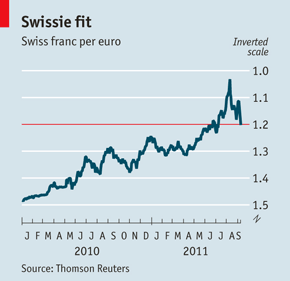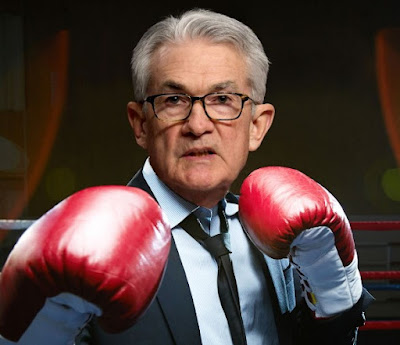| CENTRAL banks have historically been regarded as the guardians of a currency’s value, but occasionally they want to drive their exchange rates down. Rarely have they acted as aggressively as the Swiss National Bank (SNB) did on September 6th. Announcing a “minimum” exchange rate of SFr1.20 per euro (in effect, a ceiling), the SNB said it would buy “unlimited quantities” of foreign currency in exchange for Swiss francs, which have become a haven for investors fleeing the euro zone’s debt crisis. The central bank declared that: “The current massive overvaluation of the Swiss franc poses an acute threat to the Swiss economy and carries the risk of a deflationary development.” The franc fell from SFr1.11 to SFr1.20 to the euro almost immediately.
In theory, it should be much easier for a central bank to drive its currency down than to push it up. When the Bank of England was trying to keep the pound in the Exchange Rate Mechanism in 1992, it had to use its limited foreign-exchange reserves to buy sterling. But the SNB can create francs without limit if it wants to. In short, the SNB is using quantitative easing (QE) with the aim of driving down its exchange rate. Other central banks (notably the Federal Reserve) have denied that currency weakness is the explicit aim of QE, although the dollar’s weakness is regarded by enthusiasts as a positive side-effect of the policy. Given the weak economic outlook, most governments would like to see their currencies fall to give their exporters a chance of seizing a bigger share of global trade. The risk, as in the 1930s, is of “beggar-thy-neighbour” devaluations. “This marks a major new round in the currency war,” says Chris Turner, head of foreign-exchange strategy at ING. “Could not Japan also set a minimum yen/dollar exchange rate at 75 as a means to battle deflation?” The euro zone in particular may rue the Swiss move. Unlimited Swiss buying of euros could push up the single currency, adding to deflationary pressures in the region. The SNB is also likely to invest the proceeds in French and German government bonds, causing the spread between the yields on such bonds and those of Italy and Spain to widen. Such spreads are seen as a signal of risk aversion and may pile more pressure on peripheral countries. |
Swissie fit(see more posts on EUR/CHF, ) |
The Swiss felt they had no choice. They had been attempting to drive down the franc by intervening in the money markets to little lasting effect. Their exporters were suffering from the strength of the franc. Companies from Clariant, a chemicals group, to Swatch, a watchmaker, have blamed disappointing profits on the currency. UBS recently introduced a charge on institutional customers which held excess deposits in their accounts.
Imposing a ceiling carries big risks. Central banks cannot target both their exchange rate and inflation. The Swiss monetary base is almost 50% of GDP (the equivalent figure for America is 18%), although inflation remains subdued at 0.2% in August. There are also questions about what happens if the strategy fails. The SFr20 billion losses ($23.3 billion) incurred in 2010 thanks to previous interventions have sparked calls for the resignation of Philipp Hildebrand, the SNB’s president. This looks like a last throw of the dice.
Full story here Are you the author? Previous post See more for Next postTags: EUR/CHF,Swiss National Bank







































